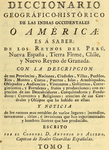About

A Historical Gazetteer for Latin America and the Caribbean. Un gazetteer histórico para América Latina y el Caribe.
LatAm es una edición colaborativa académica cuya finalidad es aportar materiales curados para crear un gazetteer histórico para Latinoamérica y el Caribe. Este sitio es una plataforma para crear la edición digital a partir de nuestras fuentes principales:
- Antonio de Alcedo Diccionario geográfico-histórico de las Indias Occidentales o América (1786), un diccionario geográfico que describe lugares dentro del Nuevo Mundo desde una perspectiva colonial y el
- Diccionario geográfico e histórico de George Alexander Thompson de América y las Indias Occidentales (1812) una versión expandida en inglés del diccionario de Alcedo que contiene añadidos y actualizaciones sustanciales. Planeamos trabajar en cada volumen, corregir el texto, marcar encabezados y ciertos topónimos dentro de cada entrada, y correlacionar las entradas dentro de Alcedo con las entradas correspondientes en Thompson.
Si te interesa colaborar con este equipo formado por miembros del Laboratorio de Humanidades Digitales (HD CAICYT) del CONICET, Argentina, Pelagios Commons, LLILAS Benson Latin American Studies and Collections, Brumfield labs (USA), HGIS de las Indias (Graz, Austria), y el world Historical gazetteer, solo tienes que sacarte una cuenta en esta plataforma (Sign up). Todas las colaboraciones estarán visibles con nombre e institución desde la plataforma y desde CONICET otorgaremos certificados de participación.
LatAm is a collaborative effort to create a HGIS gazetteer and digital scholarly edition of colonial Latin America from 18th-century sources. This site is a platform for creating a digital edition from our main sources:
- Antonio de Alcedo’s Diccionario geográfico-histórico de las Indias Occidentales ó América (1786), a gazetteer describing places within the New World from a Spanish colonial perspective
- George Alexander Thompson’s Geographical and Historical Dictionary of America and the West Indies (1812) an English-language version of Alcedo’s Diccionario containing substantial expansions and updates.
- Diccionario geográfico e histórico de George Alexander Thompson de América y las Indias Occidentales (1812) una versión expandida en inglés del diccionario de Alcedo que contiene añadidos y actualizaciones sustanciales. Planeamos trabajar en cada volumen, corregir el texto, marcar encabezados y ciertos topónimos dentro de cada entrada, y correlacionar las entradas dentro de Alcedo con las entradas correspondientes en Thompson.
Works
The geographical and historical dictionary of America and the West Indies [volume 1]
Vol. 4-5 have imprint: London, Printed for the author, and published by Carpenter and SonIncludes bibliographical references (v. 5, p. xxv-xxxv)Palau y Dulcet (2nd ed.)Sabin
Collaboration is restricted.
The geographical and historical dictionary of America and the West Indies [volume 2]
Vol. 4-5 have imprint: London, Printed for the author, and published by Carpenter and SonIncludes bibliographical references (v. 5, p. xxv-xxxv)Palau y Dulcet (2nd ed.)Sabin
Collaboration is restricted.
The geographical and historical dictionary of America and the West Indies [volume 3]
Vol. 4-5 have imprint: London, Printed for the author, and published by Carpenter and SonIncludes bibliographical references (v. 5, p. xxv-xxxv)Palau y Dulcet (2nd ed.)Sabin
Collaboration is restricted.
The geographical and historical dictionary of America and the West Indies [volume 4]
Vol. 4-5 have imprint: London, Printed for the author, and published by Carpenter and SonIncludes bibliographical references (v. 5, p. xxv-xxxv)Palau y Dulcet (2nd ed.)Sabin
Collaboration is restricted.
The geographical and historical dictionary of America and the West Indies [volume 5]
Vol. 4-5 have imprint: London, Printed for the author, and published by Carpenter and SonIncludes bibliographical references (v. 5, p. xxv-xxxv)Palau y Dulcet (2nd ed.)Sabin
Collaboration is restricted.
![The geographical and historical dictionary of America and the West Indies [volume 1]](https://www.archive.org/download/geographicalhist01alce_0/page/leaf253_thumb.jpg)
![The geographical and historical dictionary of America and the West Indies [volume 2]](https://www.archive.org/download/geographicalhist02alce_0/page/leaf208_thumb.jpg)
![The geographical and historical dictionary of America and the West Indies [volume 3]](https://www.archive.org/download/geographicalhist03alce_0/page/leaf179_thumb.jpg)
![The geographical and historical dictionary of America and the West Indies [volume 4]](https://www.archive.org/download/geographicalhist04alce_0/page/leaf218_thumb.jpg)
![The geographical and historical dictionary of America and the West Indies [volume 5]](https://www.archive.org/download/geographicalhist05alce_0/page/leaf197_thumb.jpg)